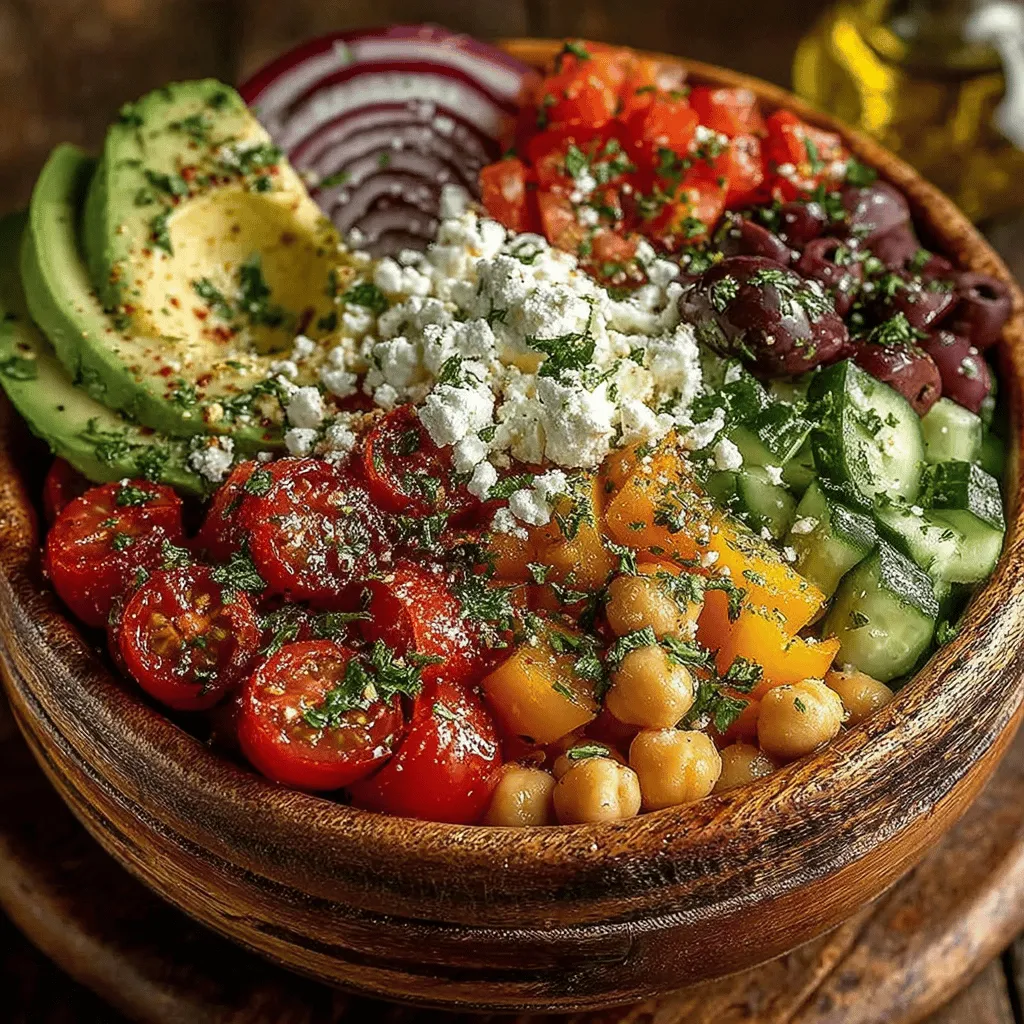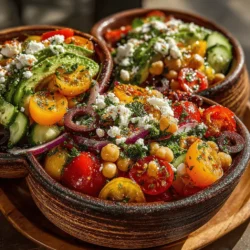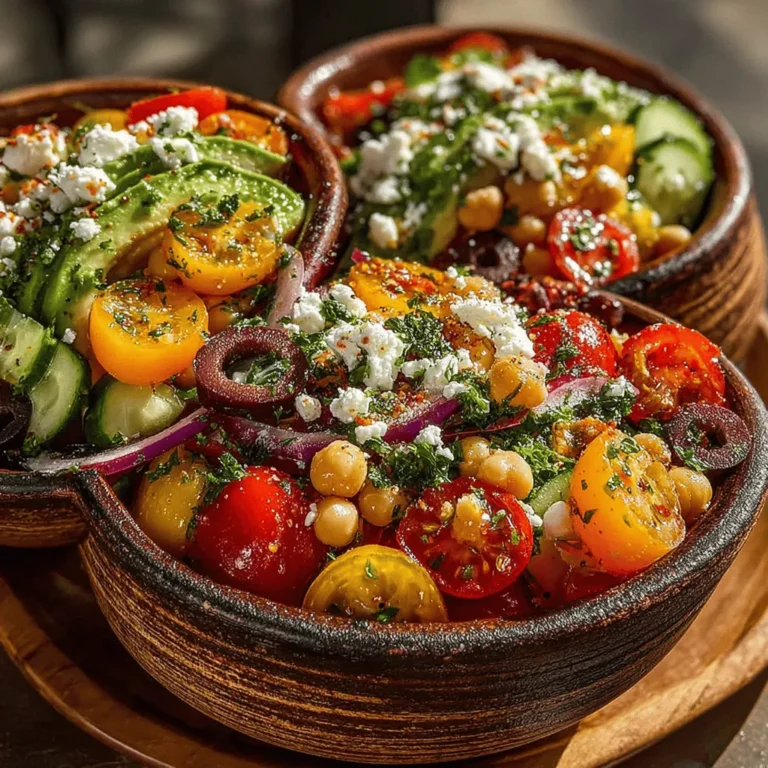Introduction
Mediterranean cuisine is celebrated for its vibrant flavors, wholesome ingredients, and health benefits. One dish that epitomizes this delightful culinary tradition is the Mediterranean Chickpea Salad Bowl. This recipe combines protein-rich chickpeas, fresh vegetables, and aromatic herbs, making it a nutritious and satisfying meal option. Perfect for lunch or as a side dish, this salad is not only easy to prepare but also packs a punch of flavor and nutrition. In this article, we’ll explore the ingredients, preparation steps, and benefits of this delicious salad, along with insightful tips to elevate your culinary experience.
The Mediterranean diet, characterized by its emphasis on plant-based foods, healthy fats, and lean proteins, has gained popularity for its numerous health benefits, including improved heart health and weight management. The Mediterranean Chickpea Salad Bowl embodies these principles, making it a smart choice for anyone looking to embrace a healthier lifestyle without sacrificing taste. Whether enjoyed on a warm summer day or as a hearty accompaniment to a winter meal, this salad is a versatile dish that adapts well to various occasions.
Understanding the Ingredients
Fresh, wholesome ingredients are the cornerstone of a Mediterranean Chickpea Salad Bowl. Each component plays a vital role in contributing to both the flavor profile and nutritional value. To truly appreciate this dish, it’s essential to understand the significance of each ingredient that comes together to create this vibrant salad.
Chickpeas: The Protein Powerhouse
Chickpeas, also known as garbanzo beans, are the star of this salad. They are an excellent source of plant-based protein, making them a perfect option for vegetarians and vegans alike. A single cup of cooked chickpeas provides approximately 15 grams of protein, along with a hefty dose of fiber, which aids in digestion and promotes a feeling of fullness. The high fiber content also helps regulate blood sugar levels, making chickpeas a smart choice for those monitoring their glycemic index.
In addition to their nutritional benefits, chickpeas enhance the salad’s texture and heartiness. Their slightly nutty flavor and firm bite complement the fresh vegetables, providing a satisfying contrast that makes each bite enjoyable. When incorporated into the Mediterranean Chickpea Salad Bowl, chickpeas not only add substance but also absorb the flavors of the dressing and other ingredients, making them a vital component of this dish.
Vibrant Vegetables for Flavor and Color
A Mediterranean Chickpea Salad Bowl wouldn’t be complete without an array of vibrant vegetables that contribute both flavor and visual appeal. The following vegetables play essential roles in creating a balanced and delicious salad:
– Cherry Tomatoes: Known for their sweetness and juiciness, cherry tomatoes add a burst of flavor to the salad. They are also rich in antioxidants, particularly lycopene, which is linked to various health benefits, including reduced risk of heart disease.
– Cucumbers: These crunchy vegetables provide a refreshing element to the dish. Their high water content makes them hydrating, while their mild flavor allows them to blend seamlessly with the bolder ingredients in the salad. Cucumbers are also low in calories, making them an excellent choice for those looking to maintain a healthy diet.
– Red Bell Pepper: Adding a touch of sweetness and a pop of color, red bell peppers are not only visually appealing but also packed with vitamins A and C. These vitamins are essential for maintaining healthy skin and boosting the immune system.
– Red Onion: With its subtle bite, red onion adds depth to the salad’s flavor profile. Its sharpness balances the sweetness of the other ingredients, creating a harmonious blend of tastes. Additionally, red onions are a good source of antioxidants and may offer anti-inflammatory benefits.
The Role of Olives and Feta Cheese
To truly capture the essence of Mediterranean cuisine, no salad would be complete without the inclusion of olives and feta cheese. These ingredients not only enhance the flavor but also contribute to the overall character of the dish.
– Kalamata Olives: Known for their rich, briny flavor, Kalamata olives add an unmistakable Mediterranean touch to the salad. They are high in healthy monounsaturated fats and antioxidants, which can help reduce inflammation and promote heart health. The salty punch from the olives complements the sweetness of the vegetables and the creaminess of the feta cheese.
– Feta Cheese: This tangy, crumbly cheese is a staple in many Mediterranean dishes. Feta cheese contributes a creamy richness that enhances the overall texture of the salad. It also provides a good source of calcium and protein, rounding out the nutritional profile of the dish. The combination of feta and olives creates a delightful contrast with the fresh vegetables and chickpeas, making each bite a flavorful experience.
Herbs that Brighten the Dish
Herbs play a crucial role in elevating the flavors in a Mediterranean Chickpea Salad Bowl. Fresh herbs not only add aromatic notes but also contribute to the dish’s vibrant color and freshness. The following herbs are commonly used in this salad:
– Fresh Parsley: A staple in Mediterranean cooking, fresh parsley adds a burst of flavor and a beautiful green hue to the salad. It is rich in vitamins K and C, as well as antioxidants, which can support overall health.
– Fresh Mint: Mint brings a refreshing quality to the dish, enhancing the overall taste experience. Its aromatic profile pairs well with the other ingredients and adds a unique twist. Fresh mint is also known for its digestive benefits, making it a great addition to any salad.
Using fresh herbs instead of dried ones is essential for maximizing flavor. Dried herbs can lose their potency over time, while fresh herbs offer a vibrant, fragrant quality that can transform a dish. For the best results, chop the herbs just before adding them to the salad to preserve their freshness and aromatic oils.
Creating the Perfect Dressing
No Mediterranean Chickpea Salad Bowl is complete without a zesty and balanced dressing. The dressing not only ties all the ingredients together but also enhances the flavors of each component. A simple yet flavorful dressing typically includes:
– Extra Virgin Olive Oil: This healthy fat serves as the base of the dressing, providing richness and depth. Olive oil is known for its heart-healthy properties and is a key component of the Mediterranean diet.
– Fresh Lemon Juice: The acidity of lemon juice adds brightness to the salad. It balances the richness of the olive oil and the creaminess of the feta cheese, creating a harmonious flavor profile.
– Dijon Mustard: A small amount of Dijon mustard adds a touch of tanginess and helps emulsify the dressing, ensuring a smooth consistency. It also enhances the overall flavor with its distinctive taste.
– Garlic: Minced fresh garlic adds a pungent kick to the dressing, infusing the salad with aromatic flavor. Garlic is also known for its numerous health benefits, including anti-inflammatory and immune-boosting properties.
The emulsification process is vital when preparing the dressing. By whisking the ingredients together, you create a stable mixture that clings to the salad components, ensuring each bite is flavorful. A well-emulsified dressing enhances the overall presentation and taste of the dish.
Step-by-Step Preparation
Now that we’ve explored the key ingredients that make up the Mediterranean Chickpea Salad Bowl, it’s time to dive into the preparation process. This salad is not only easy to assemble but also allows for creativity and personalization based on your preferences.
Preparing the Vegetables
The first step in creating your Mediterranean Chickpea Salad Bowl is to prepare the vegetables. Proper chopping and mixing techniques are essential for maintaining texture and ensuring that each ingredient shines.
– Chopping Techniques: When chopping vegetables like cherry tomatoes, cucumbers, red bell peppers, and red onions, aim for uniform sizes to promote even mixing. Use a sharp knife to make clean cuts, which helps preserve the integrity of the vegetables. For cherry tomatoes, slicing them in half allows for better distribution of flavors throughout the salad.
– Mixing Without Damage: Once the vegetables are chopped, combine them in a large mixing bowl. Gently toss them together using a spatula or your hands to avoid bruising the ingredients. The goal is to blend the flavors without compromising the crispness and texture of the fresh produce.
– Maintaining Texture: To achieve the perfect balance of flavors and textures, add the chickpeas to the vegetable mixture carefully. The chickpeas should be rinsed and drained before incorporation to remove excess sodium and preserve their taste. By folding the chickpeas into the salad gently, you ensure that they mix evenly without being smashed or broken.
With the vegetables and chickpeas prepared, you are well on your way to assembling a delightful Mediterranean Chickpea Salad Bowl. In the following sections of this article, we will delve deeper into the remaining steps, including the preparation of the dressing, combining all the elements, and presenting your salad in an appetizing way. Stay tuned to discover how to elevate your salad experience with expert tips and tricks!

Incorporating Chickpeas and Olives
To create the perfect Mediterranean Chickpea Salad, it’s essential to incorporate your chickpeas and olives with care. Begin by adding the drained and rinsed chickpeas to a large mixing bowl, followed by the sliced olives. To incorporate these ingredients effectively without mashing the chickpeas, use a rubber spatula or a large spoon to gently fold the mixture. The key is to lift and turn the ingredients rather than stirring rigorously. This method ensures the chickpeas retain their shape, providing a delightful texture in every bite.
Folding in Feta and Herbs
Next, we’ll introduce the feta cheese and fresh herbs into the mix. Crumble your feta cheese over the salad, and sprinkle in your chopped parsley and mint. When adding these ingredients, it’s important to maintain the visual appeal and not break down the feta too much. Gently fold the mixture using the same spatula technique as before—lifting the salad from the bottom and turning it over onto itself. This method ensures that the feta and herbs are evenly distributed without losing their individual characteristics.
Making the Dressing
A well-balanced dressing can elevate your salad to new heights. To create a simple yet delicious dressing, start by whisking together the following ingredients in a small bowl:
– 1/4 cup of extra-virgin olive oil
– 2 tablespoons of red wine vinegar
– 1 teaspoon of Dijon mustard
– 1 clove of minced garlic
– Salt and pepper to taste
Begin by combining the vinegar, mustard, and minced garlic in a bowl. Slowly drizzle in the olive oil while whisking continuously to emulsify the dressing. This technique creates a smooth and cohesive dressing that clings beautifully to the salad ingredients. Once combined, taste the dressing and adjust the flavors to your personal preference; you might want to add a pinch more salt or a dash of vinegar for extra acidity.
Dressing the Salad
Now that your dressing is ready, it’s time to coat your salad. Drizzle the prepared dressing over the salad mixture, ensuring that you cover all the ingredients. To achieve an even coating, gently toss the salad with your spatula once again, using the folding technique to avoid bruising the vegetables and herbs. The goal is to ensure every chickpea, olive, and vegetable piece is kissed by the dressing, enhancing the overall flavor profile of the dish.
Final Touches Before Serving
Before serving, take a moment to taste your salad. This is a crucial step to ensure the flavors are balanced. If necessary, adjust the seasoning with additional salt, pepper, or a squeeze of fresh lemon juice for brightness. Remember that the flavors will develop further as the salad sits, but it’s always good to start with a well-seasoned base.
Serving Suggestions
Individual Serving Bowls
When it comes to presentation, serving your Mediterranean Chickpea Salad in individual bowls can elevate the dining experience. Consider using clear glass or colorful ceramic bowls to showcase the vibrant colors of the salad. For an aesthetically pleasing dish, layer the salad with attention to the visual appeal—start with a base of leafy greens, followed by the chickpea mixture, and top with a sprinkle of feta and herbs. You can also garnish with a slice of lemon or a few whole olives to add a touch of elegance.
Creative Serving Ideas
This salad is versatile enough to be served at various occasions—from casual lunches to formal dinners. For a picnic, pack the salad in mason jars for easy transport, layering the ingredients in a way that keeps the dressing separate until you’re ready to eat. For a barbecue, serve the salad alongside grilled chicken or fish for a refreshing complement. You can even use it as a filling for pita pockets or wraps, making it a perfect option for meal prep.
Storage and Flavor Development
One of the beautiful aspects of the Mediterranean Chickpea Salad is its ability to improve in flavor over time. If you have leftovers, store them in an airtight container in the refrigerator. The flavors will meld as they sit, making the salad even more delightful the next day. However, to maintain the best texture, consider storing the dressing separately and adding it just before serving. This will keep your vegetables crisp and fresh.
Nutritional Benefits of the Mediterranean Chickpea Salad
This Mediterranean Chickpea Salad isn’t just a feast for the eyes; it’s also packed with nutritional benefits.
Chickpeas as a Superfood
Chickpeas are often hailed as a superfood due to their impressive nutritional profile. They are rich in protein, making them a great plant-based protein source, and are also high in dietary fiber, which supports digestive health. Additionally, chickpeas are a good source of essential vitamins and minerals, including folate, iron, and magnesium, contributing to overall well-being.
Health Benefits of Fresh Vegetables
The fresh vegetables in this salad—tomatoes, cucumbers, and peppers—are not only colorful but also provide a myriad of health benefits. Tomatoes are rich in antioxidants, particularly lycopene, which has been linked to heart health. Cucumbers are hydrating and low in calories, making them an excellent choice for those looking to maintain a healthy weight. Bell peppers offer a significant dose of vitamin C, crucial for immune function and skin health.
Heart-Healthy Fats from Olive Oil and Avocado
The healthy fats in olive oil and avocado play a vital role in a balanced diet. Olive oil is known for its heart-health benefits, including reducing inflammation and lowering bad cholesterol levels. Avocado, often an optional addition, is packed with monounsaturated fats that promote heart health and provide satiety. Including these fats in your salad not only enhances flavor but also helps your body absorb fat-soluble vitamins from the vegetables.
Conclusion
The Mediterranean Chickpea Salad Bowl is not just a meal; it’s a celebration of fresh ingredients and wholesome eating. With its vibrant colors, rich textures, and robust flavors, this salad is sure to impress anyone at your table. Whether you’re looking for a quick lunch, a side dish for dinner, or a refreshing option for summer gatherings, this recipe is a versatile and nutritious choice. Embrace the essence of Mediterranean cuisine, and enjoy the myriad health benefits this delightful salad has to offer. By incorporating simple techniques and fresh ingredients, you can create a dish that is as nourishing as it is beautiful. So gather your ingredients, mix with love, and savor every bite of this Mediterranean delight!


